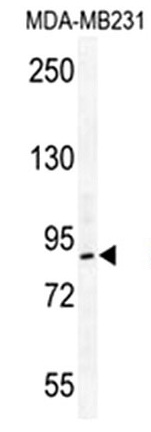PCAF Antibody (NT)
Rabbit Polyclonal Antibody
- SPECIFICATION
- CITATIONS
- PROTOCOLS
- BACKGROUND

Application
| WB |
|---|---|
| Primary Accession | Q92831 |
| Reactivity | Human, Mouse |
| Host | Rabbit |
| Clonality | Polyclonal |
| Isotype | Rabbit IgG |
| Calculated MW | 93013 Da |
| Gene ID | 8850 |
|---|---|
| Positive Control | Western blot: MDA-MB231 cell lysate |
| Application & Usage | Western blot: ~1:1000. |
| Other Names | KAT2B; PCAF; Histone acetyltransferase KAT2B; Histone acetyltransferase PCAF; Lysine acetyltransferase 2B; P300/CBP-associated factor. |
| Target/Specificity | PCAF |
| Antibody Form | Liquid |
| Appearance | Colorless liquid |
| Formulation | 100 µl of antibody in PBS with 0.09% (W/V) sodium azide |
| Handling | The antibody solution should be gently mixed before use. |
| Reconstitution & Storage | -20 °C |
| Background Descriptions | |
| Precautions | PCAF Antibody (NT) is for research use only and not for use in diagnostic or therapeutic procedures. |
| Name | KAT2B {ECO:0000303|PubMed:27796307, ECO:0000312|HGNC:HGNC:8638} |
|---|---|
| Function | Functions as a histone acetyltransferase (HAT) to promote transcriptional activation (PubMed:8945521). Has significant histone acetyltransferase activity with core histones (H3 and H4), and also with nucleosome core particles (PubMed:8945521). Has a a strong preference for acetylation of H3 at 'Lys-9' (H3K9ac) (PubMed:21131905). Also acetylates non-histone proteins, such as ACLY, MAPRE1/EB1, PLK4, RRP9/U3-55K and TBX5 (PubMed:10675335, PubMed:23001180, PubMed:23932781, PubMed:26867678, PubMed:27796307, PubMed:29174768, PubMed:9707565). Inhibits cell-cycle progression and counteracts the mitogenic activity of the adenoviral oncoprotein E1A (PubMed:8684459). Acts as a circadian transcriptional coactivator which enhances the activity of the circadian transcriptional activators: NPAS2-BMAL1 and CLOCK-BMAL1 heterodimers (PubMed:14645221). Involved in heart and limb development by mediating acetylation of TBX5, acetylation regulating nucleocytoplasmic shuttling of TBX5 (PubMed:29174768). Acts as a negative regulator of centrosome amplification by mediating acetylation of PLK4 (PubMed:27796307). Acetylates RRP9/U3-55K, a core subunit of the U3 snoRNP complex, impairing pre-rRNA processing (PubMed:26867678). Acetylates MAPRE1/EB1, promoting dynamic kinetochore-microtubule interactions in early mitosis (PubMed:23001180). Also acetylates spermidine (PubMed:27389534). |
| Cellular Location | Nucleus. Cytoplasm, cytoskeleton, microtubule organizing center, centrosome. Cytoplasm Note=Mainly localizes to the nucleus. Also localizes to centrosomes in late G1 and around the G1/S transition, coinciding with the onset of centriole formation. Subcellular location may vary depending upon cell differentiation state. Cytoplasmic at the very stages of keratinocyte differentiation, becomes nuclear at later differentiation stages Cytoplasmic in basal epithelial cells (undifferentiated cells) and nuclear in parabasal cells (differentiated cells) (PubMed:20940255) Localizes to sites of DNA damage (PubMed:25593309) |
| Tissue Location | Ubiquitously expressed but most abundant in heart and skeletal muscle. Also expressed in the skin, in keratinocytes (at protein level) (PubMed:20940255). |

Thousands of laboratories across the world have published research that depended on the performance of antibodies from Abcepta to advance their research. Check out links to articles that cite our products in major peer-reviewed journals, organized by research category.
info@abcepta.com, and receive a free "I Love Antibodies" mug.
Provided below are standard protocols that you may find useful for product applications.
Background
The acetylation of histone lysine residues plays a crucial role in the epigenetic regulation of gene transcription. A bromodomain is a protein domain that recognizes acetylated lysine residues such as those on the N-terminal tails of histones. This recognition is often a prerequisite for protein-histone association and chromatin remodeling. These domains function in the linking of protein complexes to acetylated nucleosomes, thereby controlling chromatin structure and gene expression. Thus, bromodomains serve as “readers” of histone acetylation marks regulating the transcription of target promoters. p300/CBP-associated factor (PCAF) is a transcriptional coactivator that works both as a histone lysine acetyltransferase, through its HAT domain, and as an acetyl-lysine reader through its conserved bromodomain located directly C-terminal to the HAT domain. The PCAF bromodomain binds acetylated histone H3 and H4 as well as non-histone targets. Bromodomain binding is dictated by the position of the acetylated lysine as well as interactions with specific residues flanking the acetyl-lysine. PCAF also specifically binds the HIV viral protein Tat on acetylated K50 to regulate its transactivating activity and help induce chromatin remodeling of proviral genes, thereby promoting transcription of viral proteins.
If you have used an Abcepta product and would like to share how it has performed, please click on the "Submit Review" button and provide the requested information. Our staff will examine and post your review and contact you if needed.
If you have any additional inquiries please email technical services at tech@abcepta.com.













 Foundational characteristics of cancer include proliferation, angiogenesis, migration, evasion of apoptosis, and cellular immortality. Find key markers for these cellular processes and antibodies to detect them.
Foundational characteristics of cancer include proliferation, angiogenesis, migration, evasion of apoptosis, and cellular immortality. Find key markers for these cellular processes and antibodies to detect them. The SUMOplot™ Analysis Program predicts and scores sumoylation sites in your protein. SUMOylation is a post-translational modification involved in various cellular processes, such as nuclear-cytosolic transport, transcriptional regulation, apoptosis, protein stability, response to stress, and progression through the cell cycle.
The SUMOplot™ Analysis Program predicts and scores sumoylation sites in your protein. SUMOylation is a post-translational modification involved in various cellular processes, such as nuclear-cytosolic transport, transcriptional regulation, apoptosis, protein stability, response to stress, and progression through the cell cycle. The Autophagy Receptor Motif Plotter predicts and scores autophagy receptor binding sites in your protein. Identifying proteins connected to this pathway is critical to understanding the role of autophagy in physiological as well as pathological processes such as development, differentiation, neurodegenerative diseases, stress, infection, and cancer.
The Autophagy Receptor Motif Plotter predicts and scores autophagy receptor binding sites in your protein. Identifying proteins connected to this pathway is critical to understanding the role of autophagy in physiological as well as pathological processes such as development, differentiation, neurodegenerative diseases, stress, infection, and cancer.


